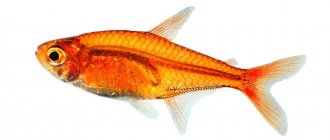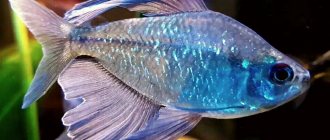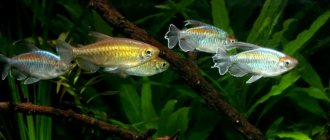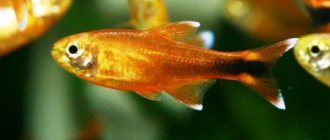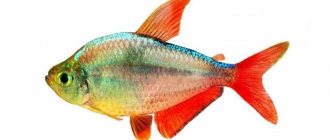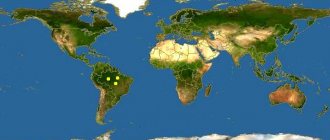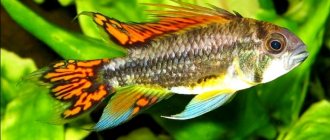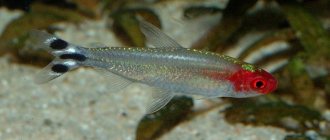Congo tetra (Phenacogrammus interruptus) Boulenger, 1899
It is a representative of the African Characinidae species, which was described by the biologist Boulanger back in 1899.
Synonyms
Russian: Rainbow Congo/Tetra, Blue Congo/Tetra, Tetra Congo, Royal Congo
Etymology
Phenacogrammus: Greek, phenax, - akos = deceptive + Greek, gramma = letter, signal.
Family: African tetras (Alestidae) Genus: Phenacogrammus tetras
Range and Habitat
Distributed in Africa. Wild populations are endemic to parts of the rivers of the Congo Basin in the Democratic Republic of the Congo.
These fish stay in small schools and prefer “black” water.
Most commercially available fish are bred for sale in Asia and Eastern Europe.
General information
Tetras is the collective name for various species of fish from the Characin family. These are small, agile and colorful fish that are a pleasure to watch. They live mainly in the rivers of South America and live in flocks.
Aquarists all over the world love tetras for their ease of keeping, bright colors and excellent compatibility with most species of small tropical fish. Tetras do not require large aquarium volumes and reproduce easily. You can meet them both in the aquariums of beginners and professionals.
It is necessary to keep fish in schools of 6-10 individuals or more. Tetras living alone either become inactive or, on the contrary, become cocky and begin to attack their neighbors in the aquarium.
A flock of red-nosed tetras
Description
The body of the fish is elongated and flat on the sides. The fins spread out in lush fans on the sides of the body during movement.
In the aquarium it displays a beautiful color that shimmers beautifully in the water. It comes in blue, red-orange and golden-yellow shades. The fins have more muted tones, these are translucent, gray-violet shades.
When mature, the Congo Tetra's rainbow colors run through the fish from front to back, starting with blue at the top, transitioning to red through the middle, to yellow and gold, and back to blue just above the belly.
There is also an albino form.
Size:
They are classified as medium-sized fish. Adults reach a size of 8-10 cm in length if we are talking about males. Females are usually slightly smaller - about 6 centimeters.
Kinds
Tetra firefly (Hemigrammus erythrozonus)
It lives in Western Guyana, in the Essequibo River basin. Prefers bodies of water with weak currents and “black” water.
Body color is gray-green. On each side there is a clearly visible luminous red-orange stripe running across the entire body. With age it becomes brighter. The iris of the eyes is two-colored: red above, blue below. The maximum size is 4 cm.
It is necessary to keep fish in schools of 8-12 pieces. The recommended aquarium volume is from 60 liters. Gets along well with any peaceful neighbors.
Tetra firefly
Royal tetra (Nematobrycon palmeri)
This species is native to the small rivers and streams of Colombia that flow under the dense canopy of tropical rainforests. Prefers soft and acidic water.
The size of adult individuals does not exceed 6 cm. The body color is pinkish-brown with a bluish or purple tint. A wide black stripe stretches from head to tail. The king tetra has a uniquely shaped tail with an elongated central ray. The adipose fin is absent. The anal fin has a yellow edge. The iris of the eyes is blue. Sexual dimorphism is well expressed.
Keeping in schools in aquariums from 60 liters. The character is peaceful.
Tetra regal
Amanda's tetra (Hyphessobrycon amandae)
In nature, Amanda's tetra is found in the central regions of Brazil. Inhabits small channels, streams, and oxbow lakes. Prefers sandy soil covered with a layer of leaves and branches, soft and acidic water.
A very small tetra, the size of an adult does not exceed 2 cm. The main feature of the fish is its color. The body of this tetra has a rich red-orange color, for which it is often called the fire tetra. Sexual dimorphism is weakly expressed.
Amanda's tetra is kept in flocks in aquariums of 40 liters or more.
Amanda's tetra
Tetra von Rio (Hyphessobrycon flammeus)
Lives in southeast Brazil. Prefers shallow tributaries and streams with dense aquatic vegetation. Unfortunately, natural habitats are greatly affected by human activity, and fish in their natural environment are in danger of extinction.
The specific epithet "flammeus" means "fiery" and refers to the bright orange-red coloration of the rear part of the body. The head is silver, the fins are brick red. Two dark transverse stripes are clearly visible behind the gills. The fish grow up to 4 cm in length.
They feel best when kept in flocks of 8 or more individuals. The recommended aquarium volume is from 50 liters.
Tetra von Rio
Copper tetra (Hasemania nana)
The natural habitat of this species is the Brazilian São Francisco River.
The fish grows up to 5 cm in length. The body is silvery with a rich copper tint, for which the tetra is often called “copper”. There is a black stripe at the base of the tail, and the tips of the unpaired fins are white.
The fish are kept in schools of 8-10 individuals. It is best to opt for an aquarium of at least 60 liters.
Copper tetra
Lanternfly tetra (Hemigrammus ocellifer)
The species is widespread throughout tropical South America. The fish is found in Brazil, Peru, Guyana, Suriname and other countries. They prefer tributaries and streams with slow flows.
The body color is silver. A barely noticeable yellow stripe stretches along the sides. Behind the gills and at the base of the caudal fin there is a dark round spot. The fish got its name from the bright red color of the iris, which flashes under certain lighting. Sexual dimorphism is weakly expressed.
They feel comfortable only in a flock. The character is peaceful, suitable for sharing with most small fish. The recommended aquarium volume is from 60 liters.
Tetra flashlight
Diamond tetra (Moenkhausia pittieri)
One of the most beautiful tetras. In nature, it is found only in Lake Valencia (Venezuela).
A stocky fish with a flattened body. The body size does not exceed 6 cm. A unique feature of the tetra is its special scales, which are capable of reflecting and refracting incident light in such a way that they look like small diamonds. True, a similar effect is observed mainly in adult individuals; juveniles have an unremarkable gray color. A small blue stripe stretches from the middle of the body to the tail. The fins are elongated.
Water for keeping diamond tetras must be soft, acidic and very clean. It is necessary to place fish in schools in aquariums of 60 liters or more.
Diamond tetra
Red-nosed tetra (Hemigrammus bleheri)
The red-nosed tetra is native to South America. Schools of these fish can be found in the Rio Negro, Colombia, Orinoco rivers and numerous tributaries of the Amazon. The water in these reservoirs is acidic and soft, has a brownish tint, due to the high content of tannins - products of organic decay (fallen leaves, tree roots, etc.).
The size of an adult does not exceed 5 cm. The body is silvery, with a greenish tint. The fins are transparent. Tail with black and white stripes. The main distinguishing feature is the red spot on the head, for which the fish got its name.
Rhodostomus are schooling fish, so it is recommended to keep 6-8 individuals. For this number of red-nosed tetras, a container of 60 liters or more is suitable.
Red-nosed tetra
Congo tetra (Phenacogrammus interruptus)
Endemic to the Congo River Basin in Central Africa. Fish prefer “black” tropical water. They live in small groups.
The size of an adult male can reach 8 cm, females - up to 6 cm. The body color is replete with iridescent colors: blue back and abdomen, red-orange sides. The fins are veiled. The tail has an unusual shape due to protruding central rays.
Must be kept in groups of 4 or more individuals. Recommended aquarium volume is from 150 liters.
Tetra Congo
An attractive feature of tetra fish is their relatively small size. This means that an aquarium of 30 liters or more will be sufficient for maintenance. It is advisable that it be equipped with a lid, because active tetras are good jumpers.
Fish look best in aquariums designed in a natural style, imitating natural biotopes. Quartz sand or small pebbles are used as soil. It’s better to stay on dark soil; the tetras will look much brighter on it. A variety of stones, grottoes, and driftwood are used as decorations. The latter are not only a good shelter, but also release useful tannins into the water. If sand is chosen as the soil, it is useful to put Indian almond leaves on the bottom. It is better not to place sea shells in the aquarium; they will increase the level of hardness.
It is recommended to plant a large number of live plants, while not forgetting to leave room for the tetras to swim. Fish love dim light, so it is better to plant plants that do not require bright lighting. Vallisneria, cryptocorynes, anubias, mosses and ferns are good choices.
Amanda's tetra in an aquarium with live plants
The aquarium must be equipped with a filter and compressor, as well as a thermostat, because tetras are heat-loving fish. You need to change up to 20% of the water weekly. It is useful to add conditioner with Tetra ToruMin natural peat extract to create the effect of “black” tropical water.
Optimal water parameters for keeping: T=24-27°C, pH=6.0-7.0, GH<15.
Tetras are peaceful creatures and are suitable for keeping with most types of small tropical fish of similar size and temperament. Guppies, zebrafish, rasboras, platies, neons, cardinals and other tetras are perfect neighbors for them. Peaceful catfish (ancistrus and corydoras) and shrimp also get along well with tetras.
You should not add tetras to goldfish and large aggressive cichlids, because bright and nimble tetras can become an object of gastronomic interest for the latter.
Tetras get along well with any peaceful fish species
Behavior and Compatibility
This is an amazingly beautiful, active, peaceful, schooling aquarium fish. It is advisable to keep them in large aquariums as they need a lot of space to swim. In addition, it is important that the lighting in the aquarium is dim. These fish are quite shy and secretive, especially if there are other aggressive species in the aquarium. They may become frightened by loud noises and sudden movements nearby.
Recommended for most community aquariums, however, keep in mind:
They are also quite shy fish, especially if they are not kept in a school; it is recommended to keep 6 or more individuals. It is also important that they are surrounded by fish of similar sizes. Rainbowfish, Corydoras and various peaceful cichlids will be excellent neighbors. They should not be housed with aggressive fish or those that are capable of biting their fins - the spectacular fins of the males will simply be destroyed. Small fish in a community aquarium with this tetra will not feel comfortable due to their larger size and more active behavior.
Not suitable for keeping with shrimp.
Possible problems
The Congo fish is sick due to improper conditions. Impaired filtration, small aquarium volume, etc. - all this leads to the accumulation of poisons in the water. The immunity of individuals drops, and they begin to get sick. Therefore, if the inhabitants of the aquarium begin to die, the first thing you need to do is check the conditions of detention and put them in order.
If fluff appears on the fish, it is sick
Stress is also a risk factor. It is caused by small spaces and aggressive neighbors. Intimidated individuals are distinguished by unusual behavior, pinched fins and pale color. Buying and transporting fish itself is stressful for her. To reduce it, turn off the aquarium lighting and do not disturb it for 12 hours after putting the newcomer into the water.
The appearance of fluff, moss and cotton wool on the body of the fish is a consequence of fungal diseases. With bacterial lesions, swellings, ulcers, bruises or mucus appear on the scales. It is better to place sick individuals in a separate aquarium for the duration of treatment. It is advisable to do this if any suspicious symptoms appear. The use of medications is discussed with a veterinarian , since each case requires an individual approach.
Aquarium
The size of the aquarium is 120*30*30 cm for a group of adult fish; young fish can be kept in smaller aquariums.
If they are kept in small numbers, about six individuals, then an aquarium of 100 liters or more will suit them. The fish will be less shy if the aquarium uses dark soil and dim lighting. This kind of light can be created by adding plants to the aquarium that will float on the surface of the water.
Ideally, an aquarium with an African biotope, with driftwood and branches, floating vegetation and Anubias. They will show you their best colors in any well-maintained aquarium with plenty of swimming space. The water should be on the acidic side, neutral or soft, with good circulation.
Water parameters:
Temperature: 23 - 28° C pH: 6.0 - 7.5 Hardness: 3 - 18° dGH
Regular water changes of 20-25% per week.
Very sensitive to water quality and if good quality is not maintained, male fin development may be impaired and the fish will lose color.
Nutrition
In a home aquarium, they can be classified as omnivorous fish. The diet includes all types of live, dry and plant foods; in order to maintain an optimal balance, it is necessary to serve high-quality dry food (natural or frozen), as well as “pamper” with bloodworms and small earthworms. Vegetable supplements (vegetable flakes, chopped lettuce or spinach) are recommended to be supplied on a regular basis, otherwise there is a risk of damage to the leaves and shoots of the plants in the aquarium.
The Congo Tetra is widely bred for commercial purposes and has been successfully adapted to life in the artificial environment of aquariums for many decades. A prerequisite is clean water and good circulation. A high-performance internal filter solves both of these problems. At least 25 - 50% of the water should be renewed every two weeks. The minimum set of equipment consists of a filter, an aerator, a heater and a low-power lighting system. This species prefers dense vegetation along the walls of the aquarium and dark soil. River sand should be used as a substrate, and the decorative elements can be driftwood, pieces of wood, intertwined roots, etc. Adding a few dry leaves will color the water light brown, which is typical for the natural habitat. They should be replaced every two weeks.
Tetra Congo contents
Sexual Dimorphism
The male is larger and much more brightly colored.
Males are also distinguished by long veil-like processes that are located on the tail, as well as the dorsal and anal fins. In addition, the male has a three-lobed tail, in which the middle blade protrudes slightly forward.
These fish are capable of reproduction when they reach the age of about 10 months.
Keeping koi carp in a pond
In captivity, Japanese koi can live quite a long time, ranging from 25 to 35 years.
There are known cases of very decent age of fish - 220 years. Koi carp can grow up to 130 centimeters in length, which is typical for some breeds that are genetically closer to their ancestor, the wild carp. But usually their length does not exceed 90-100 centimeters.
With that said, it is of course better to keep koi in a pond rather than an aquarium.
The pond can be built on a concrete base and soft waterproofing. The latter uses synthetic rubber (EPDM). With its help you can create ponds of any shape and size. If there are sharp stones in the ground, then it is also necessary to use fleece (a special backing), which will prevent damage to the EPDM film used. A pond with a concrete base is more expensive, but also the most durable. A concrete pond allows you to create steep vertical banks, which saves space while increasing the water volume of the pond. Forum about keeping fish in a pond here.
Do-it-yourself pond in the home garden #1#2#3#4#5#6
Recommended minimum pond sizes:
— depth from 1.4 m.
— volume 8 tons (3m x 2.46m x 1.23m).
It should be remembered that these brocade koi are quite active fish, they need to swim, and accordingly they need a spacious pond. Naturally, there is no specific data on how deep and volume the pond should be, since it all depends on how many koi carps you want to put in the pond.
Recommendations for the location of the pond: a quiet, calm corner of the garden (as far as possible from noisy places, such as roads), but close to the house (so that you can admire the koi in any weather without leaving the house). The sun's rays should illuminate the pond all day.
During melting snow or rain, water from the adjacent areas should not flow into the pond. To do this, a storm drainage is built around the pond or the pond is created elevated.
It is important to equip the pond with a powerful two-stage filtration system: biological and mechanical. It must guarantee the effective removal of fish waste products and nitrogen cycle products: ammonia, nitrite and nitrate from water, as well as maintain normal gas conditions
In a flowing, large pond with aquatic plants, in principle, the filtration system can not be used. But there is a chance that koi will begin to eat underwater vegetation or dig in the ground in search of food. Therefore, the optimal options for setting up a filtration system are: build an additional regeneration pond with aquatic plants or create a bioplato - a stream or small pond, entirely covered with pebbles with aquatic plants planted in it, through which water will circulate from the pond.
Most of the factors that affect biological balance depend on the volume of the pond: the amount of dissolved oxygen, temperature conditions. Thus, the larger the pond, the easier it is to maintain biological balance.
Breeding
Reproduction is not easy, but it may be an egg-laying species.
Producers select active and most brightly colored males and larger females, which were previously intensively fed using live and frozen food.
A small spawning aquarium with a net on the bottom. The eggs pass through the mesh cells, which minimizes the risk of being eaten by the parents. To stimulate spawning, the lighting should be dimmed and plants added, since in nature spawning occurs among vegetation. The water should be below neutral pH and soft.
Water parameters in the spawning aquarium: 25-28° C; dH 2-3°; pH 6.0-6.5.
After the male pursues the female, spawning occurs. Up to 300 large eggs can be spawned by a single female during spawning, although numbers of 100-200 are more common.
During the first 24-48 hours of incubation, unfertilized and whitened eggs should be removed using a long pipette. The larvae hatch in about 6 days, when they swim and the yolk sacs disappear (about 24 hours), ciliates should be offered, and then after 2-3 days Artemia nauplii or other microfood.
You can plant a group of fish at once for spawning. At the same time, it is important that the spawning aquarium be more spacious.
Typically, the life expectancy in an aquarium under favorable conditions is about five years.
Feeding
An omnivorous fish that feeds on small worms, insects, crustaceans, algae and other zooplankton in nature. In an aquarium, feeding it is not difficult; almost all types of food are suitable, but live and frozen food should make up a good proportion of the diet for the fish to show its best coloring.
Congo will also eat artificial food without any problem: flakes, granules, the main thing is that the fish can swallow them.
But these are rather timid fish, they cannot keep up with their lively neighbors and may not even take food while you are nearby. It is advisable to feed them in separate portions.
